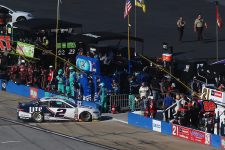TALLADEGA, Ala. — The final run to the finish had five lead changes, and Aric Almirola took the lead with four laps remaining to win a competitive XFINITY Series Sparks Energy 300 at Talladega Superspeedway.
Justin Allgaier led the field to the final restart with 11 laps to go. Joey Logano, with Almirola in tow, powered down the backstretch and “chicaned” around Allgaier to take the lead with nine to go. He swapped the lead with Erik Jones before Jones was edged out by Almirola coming to the line with four to go and Almirola drove on to score the victory.
Elliott Sadler came home second and Joey Logano finished third.
Ben Kennedy and Erik Jones rounded out the top-five.
Matt Tifft, Michael Annett, Justin Allgaier, Daniel Suarez and Jeff Green rounded out the top-10.
Blake Koch led the field to the green flag at 1:21 p.m., but Kasey Kahne used a push from the outside lane on to lead the first lap. Kennedy took the lead on the sixth lap. Ray Black Jr. brought out the first caution on the seventh lap for a blown engine.
On the ensuing restart on lap 11, Kahne retook the lead. Logano took the lead for the first time on lap 16, edging out Suarez at the line. Almirola followed suit on lap 20, edging out Logano at the line. The following lap on the backstretch, Brennan Poole attempted to thread the needle between Kasey Kahne, Tifft and Suarez. He made contact with Tifft, who hooked him into the left-rear corner panel of Suarez, which sent him spinning, triggering a nine-car spin and bringing out the second caution.
Red flag was displayed for nine minutes and 28 seconds.
The race restarted on lap 23 and ran to the end of the first stage, two laps later, that was won by Almirola.
Michael Annett, who opted not to pit, led the field to the restart on lap 32, and lost the led to Ty Dillon on lap 34. Dillon and Logan swapped the lead back and forth for the next few laps until Jones powered by on the top coming to the line on lap 47 to take the lead. Allgaier jumped in front to take the lead on lap 48.
A second multi-car wreck, triggered by Almirola bumping Ryan Reed, sending him into the wall and collecting Brendan Gaughan in the process, brought out the fourth caution on lap 49 and ended the second stage with Allgaier in the race lead.
The multi-car wreck brought out an 11-minute and 30-second red flag.
Back to green on lap 55, Jones retook the lead on lap 59, only to lose it on the backstretch the following lap to Almirola, who then lost it to Kahne.
With 44 to go, the top-six cars had broken away from the field. Three of the six, including race leader Kahne, pitted with 43 to go. Jones, who inherited the lead, pitted the following lap, giving the lead to Jeff Green.
Green led 18 laps, the most he’s led in an XFINITY Series race since Rockingham in 2002, but pitted with 24 to go and the lead cycled back to Allgaier.
Debris brought out the final caution with 16 to go, setting up the 11-lap run to the finish.
The race lasted two hours, nine minutes and 41 seconds at an average speed of 139.068 mph. There were 28 lead changes among 14 different drivers and five cautions for 20 laps.
Sadler leaves Talladega with a 29-point lead over Allgaier.
[pdf-embedder url=”http://www.speedwaymedia.com/wp-content/uploads/2017/05/N1709_UNOFFRES.pdf”]










